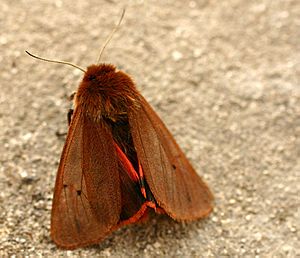Ruby tiger facts for kids
Quick facts for kids Ruby tiger |
|
|---|---|
 |
|
| Phragmatobia fuliginosa, Dorsal view | |
 |
|
| Side view | |
| Scientific classification | |
| Synonyms | |
|
List
Phalaena Noctua fuliginosa Linnaeus, 1758
Spilosoma fuliginosa fervida Staudinger, 1871 Phragmatobia fuliginosa lurida Rothschild, 1910 Phragmatobia fuliginosa meridionalis Tutt, 1904 Phragmatobia fuliginosa totirubra Vorbrodt, 1914 Phragmatobia fuliginosa monticola Daniel, 1970 Spilosoma fuliginosa borealis Staudinger, 1871 Phalaena fuliginosa melitensis O. Bang-Haas, 1927 Phragmatobia fuliginosa nawari Ebert, 1973 (only a darker mountain form) Spilosoma fuliginosa pulverulenta Alphéraky, 1889 Phragmatobia fuliginosa pallida Rothschild, 1910 Phragmatobia fuliginosa thibetica Strand, 1919 Arctia rubricosa Harris, 1841 Phragmatobia dallii Packard, 1870 |
The ruby tiger (scientific name: Phragmatobia fuliginosa) is a beautiful moth. It belongs to a group of moths called the Erebidae family. These moths are known for their bright colors and furry bodies.
Contents
What Does the Ruby Tiger Moth Look Like?
The ruby tiger moth is a medium-sized moth. Its wingspan (the distance from one wingtip to the other) is usually between 35 and 45 millimeters. That's about the length of a few paperclips!
Colors and Patterns
The main part of its body and its front wings are a dark reddish-brown color. You might see a black, comma-shaped spot on each front wing. This spot often has a bright red edge.
The back wings are a striking carmine, which is a deep red color. These back wings can look a bit see-through near the front edge. They also have black spots that might blend together.
Eggs, Larvae, and Pupae
The eggs of the ruby tiger moth are a reddish-grey color. When the eggs hatch, they become larvae, also known as caterpillars. These caterpillars can be light or dark grey and have a black-brown head.
What makes them special is that their entire body is covered in foxy-red hairs! These hairs are sometimes darker, almost black-brown. After the caterpillar stage, they turn into a pupa. The pupa is black, with yellow markings on its body segments.
Where Does the Ruby Tiger Moth Live?
The ruby tiger moth can be found in many parts of the world. It lives across the Palearctic realm, which includes most of Europe, North Africa, and a large part of Asia.
You can also find this moth in Russia, Central Asia, and Tibet. Interestingly, it also lives in the northern areas of North America.
What is the Ruby Tiger's Home Like?
This moth likes to live in places that are a bit damp and open. You can find it in forests and meadows. It also enjoys mixed hardwood forests that are not too high up.
Open fields, prairies, and even farm areas are good homes for them. They are often seen on low-growing plants, near roads, and on railway banks. Sometimes, on warm winter days, the caterpillars come out of hiding. They can be seen quickly moving along paths and roads.
Life Cycle of the Ruby Tiger Moth
The ruby tiger moth usually flies during the warmer months. Depending on where it lives, you might see it from May to August.
In places like southern England, they can have two generations in one year. This means they fly from April to June, and then again in August and September. Further north, they usually have only one generation, flying in June.
What Do Caterpillars Eat?
The caterpillars of the ruby tiger moth are not picky eaters. They are called "polyphagous," which means they eat many different kinds of plants.
Some of their favorite foods include:
- Rubus fruticosus (like blackberry bushes)
- Prunus spinosa (blackthorn bushes)
- Filipendula ulmaria (meadowsweet)
- Plantago lanceolata (ribwort plantain)
- Senecio jacobaea (ragwort)
- Different types of Salix (willow trees)
- Polygonum species (knotweeds)
- Rumex crispus (curly dock)
- Potentilla erecta (tormentil)
- Rubus idaeus (raspberry bushes)
- Different types of Trifolium (clover)
- Chamaenerion angustifolium (fireweed)
- Calluna vulgaris (heather)
- Vaccinium myrtillus (bilberry)
- Vaccinium uliginosum (bog bilberry)
- Andromeda polifolia (bog rosemary)
- Plantago major (common plantain)
- Taraxacum vulgare and Taraxacum officinale (dandelions)
Images for kids
See also
 In Spanish: Phragmatobia fuliginosa para niños
In Spanish: Phragmatobia fuliginosa para niños





